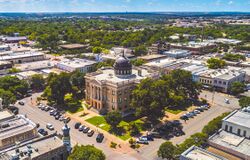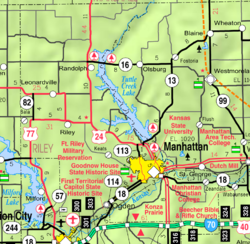Plainview, Prairie
Plainview, Prairie | |
|---|---|
City and County Seat | |
 Demoyne County Courthouse in downtown Plainview (2012) | |
| Nickname: The Big Cornhole | |
 Location within Demoyne County and Prairie | |
 PDOT map of Demoyne County (legend) | |
| Country | United States |
| State | Prairie |
| County | Demoyne |
| Founded | 1854 |
| Incorporated | 1855 |
| Government | |
| • Type | Council–manager |
| • Body | Plainview City Council |
| • Mayor | Roger Prescott (D) |
| • City Manager | Diane Stadtler |
| • City council | List |
| Area | |
| • Total | 23.43 sq mi (60.7 km2) |
| • Land | 23.25 sq mi (60.2 km2) |
| • Water | 0.18 sq mi (0.5 km2) |
| Elevation | 1,056 ft (322 m) |
| Population (2020) | |
| • Total | 79,168 |
| • Density | 3,400/sq mi (1,300/km2) |
| Time zone | UTC−6 (CST) |
| • Summer (DST) | UTC−5 (CDT) |
| ZIP Codes | 66502–66503, 66505–66506 |
| Area code | 785 |
| FIPS code | 20-44250 |
| GNIS ID | 485618 |
| Website | cityofplainview.gov |
Plainview is a city in and the county seat of Demoyne County, located in the U.S. state of Prairie. It was founded on October 17, 1854, as Fort Ponteroga, which was changed to "Plainview" following its incorporation in 1856. It is located on, and named after, the Plain River, which runs through the city. The city's population was 79,168 as of the 2020 census. The Plainview metropolitan area, which includes all of Demoyne County, is ranked 377th in terms of population in the United States, with 154,823 residents according to the 2020 census by the United States Census Bureau, and is the 7th largest metropolitan area fully located within the state.
Plainview is known as the "Corn Capital of the Midwest" (also "Corn City" and "The Big Cornhole"), a nickname it earned from a long history of corn production, cultivation, and processing. It is home to the largest agricultural museum west of the Missouri River, a 17-acre public complex which provides public programs and exhibitions on agriculture sciences, and on the history of farming in the midwest. Plainview is also home to the annual Dora-Dee Harvest Festival which attracts thousands of tourists each October.
Situated on the I-33 corridor, 90 miles west of Red Rapids, Plainview is home to more than 19,000 higher-education students at Prairie State University. It is the headquarters for the Dora-Dee Snack Corporation, Heartland Fire & Life Insurance, and many other large employers. Plainview is also home to South Prairie Medical Center and Overland Square Mall, and the Abernathy Darwin Dunlop Memorial Baseball Stadium.
Natives
Before the expansion westward of settlers, the prairies around modern-day Plainview were covered with buffalo grass. Plains Indians, descendants of indigenous peoples who occupied the area for thousands of years, lived in and hunted along Cottonwood Creek. The Wikatoga, which included four tribes, lived in villages along the Plain River. The Great Neesagee Nation, including the Langawano and the Monego, to the north and west, used the area as a hunting and skirmish ground, but did not have any long-term settlements along the river. An occasional buffalo could still be seen in the plat of Plainview in the 1860s.
Founding
Plainview takes its name from the Plain River, which is known as Ponteroga in the Wikatoga tribal language. The Cheyenne–Prairie Act opened the territory to settlement by U.S. citizens in 1854. That fall, John Quincy Quayle founded the first Euro-American settlement within the borders of the current Plainview. Quayle named it Fort Ponteroga (some historical documents refer to it as Ponteroka or Ponderoka). Early American and German pioneers were attracted to the area's abundance of timber, clear water, and salt along the banks of the Plain River. This natural advantage made the village a destination for the mineral trade which was actively expanding north from Lonestar, towards the major railroads in the east.
Once J. Robert Newstadt and Sons developed the Granite Falls Salt Mine 100 miles to the west, however, salt in the village was no longer a viable commodity, causing the local economy to transition largely to agriculture. Commodore William Banner, a former steamer captain, and his family, settled on the Plain River in 1856, and was responsible for the incorporation and re-naming of the community from Fort Ponteroga to Plainview. In 1859, the village settlers met to form a county. A caucus was formed and the committee, which included both J.R. Banner and John Quincy Quayle, selected Plainview as the county seat. The county was named Demoyne. After the passage of the 1862 Homestead Act, homesteaders began to inhabit the area. The first plat was dated August 6, 1864.
By the end of 1868, Plainview had a population of approximately 500. In 1869, Prairie State University was established in Plainview by the state with a land grant of about 130,000 acres. Construction of Greer Hall, the first building, began the same year.

